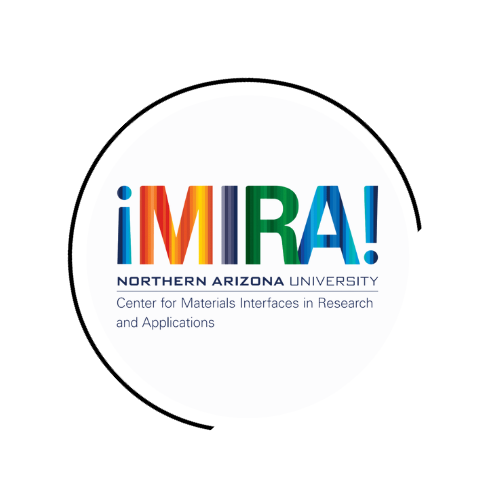
Robert S. Kellar
AssocIATE Professor of Practice
Department of Biological Sciences
Contact information
Phone: (928) 523-9311
Email: Robert.kellar@nau.edu
Office: Bldg 21
About
We have an ongoing research efforts which focus on developing and characterizing novel biomaterials as well as modifications to existing biomaterials to improve their function. These activities span numerous medical applications such as new biomaterial development, stent graft technology, cardiovascular applications of biomaterials, and wound healing treatment using biomaterials. Biomaterials have had tremendous clinical success as a result of significant efforts within basic research to help improve attributes such as their composition, architecture, and biological response. The design inputs of these attributes varies depending upon the research or clinical need of a material, and in this way biomaterial specificity has been established in the field. An important objective in the development of bioengineered materials for tissue regeneration is the synthesis and evaluation of polymer scaffolds with desirable properties, including strength, elasticity and biocompatibility. The use of natural or near-natural starting materials in polymer structures has the advantages of an established level of performance and congruence, but human sources are not always available. An important example is human elastin, one of the most abundant proteins in organs that require flexibility as part of their essential functions, including the skin, lungs, blood vessels, and bladder. In our lab, a project of interest focuses on the development of an all human-derived scaffold containing elastin.
Tropoelastin scaffolds are also conducive to cell attachment and growth, and may promote tissue regeneration processes. Human embryonic palatal mesenchymal cells proliferate much more rapidly on tropoelastin scaffolds than within the standard tissue culture-treated polystyrene matrix. Various human epithelial cells have also been shown to proliferate in tropoelastin scaffolds. Tropoelastin, elastin and peptides derived from these molecules strongly attract fibroblasts and other regenerative cells from the surrounding healthy tissue by chemotaxis. These data suggest that tropoelastin may accelerate tissue growth and regeneration in a supporting scaffold that self-assembles during fibrillogenesis. Tropoelastin would participate as a reinforcing material in a newly constructed, cell-based tissue, which usually lack elastin during adult tissue regeneration. The presence of elastin would more closely resemble the provisional matrix that is created during the development of tissues in utero.
Links to learn more about Dr. Kellar’s research:
Professional Experience
Director, Imaging & Histology Core Facility(IHCF), Northern Arizona University (2015-current)
Associate Professor of Practice in Biological Sciences, Adjunct Professor in Mechanical Engineering, Northern Arizona University (2015-current)
Lecturer in Biology & Adjunct Professor in Mechanical Engineering, Northern Arizona University, Flagstaff, AZ (2013-2015)
Instructor in Biology & Adjunct Professor in Mechanical Engineering, Northern Arizona University, Flagstaff, AZ (2008-2013)
President / Co-owner, Development Engineering Sciences, LLC, Flagstaff, AZ (2004-current)
Thoracic Aortic Graft Product and Oral Health Product Specialist, WL Gore & Associates, Flagstaff, AZ (2003-2007)
Honors and Awards
Awardee, Research and Creative Activity (RCA), Northern Arizona University, “Most Significant Innovation in Technology Transfer of Commercialization”, 2020
Arizona Business Magazine’s Healthcare Leadership Awards, Researcher of the Year, 2019
Arizona Business Magazine’s Healthcare Leaders Award, 2019
President, Surfaces in Biomaterials Foundation (2018-2019)
Global Health & Pharma’s “Most Innovative Regenerative Medicine Research Company – USA”, 2018
Co-Director, Bioengineering PhD Program, Northern Arizona University (2016-2019)
Core Faculty, Center for Bioengineering Innovation(CBI), Northern Arizona University (2015-2019)
Outstanding Teacher of the Year, Department of Biological Sciences, NAU, 2016
Highlighted Research
Ensley, B and Kellar, RS. US Patent # 9,114,128. Tropoelastins and Uses Thereof. Issue date: 8-25-2015.
Eller, Z, Hall, JW, Kellar, RS, Simmons, RL, Radford, J, Dolmatch B. US Patent # 9,655,710 B2. Process of Making a Stent. Issue date: 5-23-2017.
Kellar, RS, Nieto, NC, Koppisch, A, Del Sesto, R. US Patent # 10,293,080 B2. Ionic Liquids That Sterilize and Prevent Biofilm Formation in Skin Wound Healing Devices. Issue date: 5-21-19.
Kellar, RS, Landeen, L, Shepherd, BR, Ratcliffe, A, Naughton, G, Williams, SK. Scaffold-Based, Three-Dimensional Human Fibroblast Culture Provides a Structural Matrix That Supports Angiogenesis in Ischemic Heart Tissue. Circulation. 104:2063-2068. 2001.
Kidd, KR, Dal Ponte, D, Kellar, RS, Williams, SK. A Comparative Evaluation of Porous Material Implant Healing in the Rat and Mouse.” Journal of Biomedical Materials Research. 59 (4): 682-689. 2002.
Kellar, RS, Shepherd, BR, Larson, DF, Naughton, GK, and Williams, SK. Cardiac Patch Constructed from Human Fibroblasts Attenuates Reduction in Cardiac Function after Acute Infarct. Tissue Engineering, 11(11/12):1678-1687. 2005.
Machula, H., Ensley, B., Kellar, RS. Electrospun Tropoelastin for Delivery of Therapeutic Adipose Derived Stem Cells to Full Thickness Dermal Wounds. Advances in Wound Care. 3(5):367-375. 2014
Pinto B., Tabor, AJ., Stearns, D., Diller, R., Kellar, RS. A Bench-Top in vitro Wound Assay to Demonstrate the Effects of Platelet-Rich Plasma and Depleted Uranium on Dermal Fibroblast Migration. Applied In Vitro Toxicology. 2(3):151-156. (2016).
Kellar, RS., Diller, RB., Tabor, AJ., Dominguez, DD., Audet, RG., Bardsley, TA., Talbert, AJ., Cruz, N., Ingraldi, A., Ensley, BD. Improved Wound Closure Rates Mechanical Properties Resembling Native Skin in Murine Diabetic Wounds Treated with a Tropoelastin and Collagen Wound Healing Device. Journal of Diabetes and Clinical Research. Volume 2, Issue 3., 2020.
Bardsley, TA., Evans, CL, Green, JR, Audet, R, Harrison, MJ, Zimmerman, M, Nieto, NC, Del Sesto, RE, Koppisch, AT, Kellar, RS. Integration of choline geranate into electrospun protein scaffolds affords antimicrobial activity to biomaterials used for cutaneous wound healing. J Biomed Mater Res. 1-12, DOI: 10.1002/jbm.b34788, 2020.
[/kc_column_text][kc_title text=”UGF0ZW50cw==” _id=”935572″ type=”h2″ class=”page-title font-md lil-line”][kc_column_text _id=”903242″]
Ensley, B and Kellar, RS. US Patent # 9,114,128. Tropoelastins and Uses Thereof. Issue date: 8-25-2015.Hall, JW, Simmons, RL, Hopkinson, A, Dolmatch, B, Eller, Z, and Kellar, RS. US Patent # 9,198,999. Drug-eluting Rotational Spun Coatings and Methods of Use. Issue date: 12-1-2015.
Eller, Z, Hall, JW, Kellar, RS, Simmons, RL, Radford, J, Dolmatch B. US Patent #9,655,710 B2. Process of Making a Stent. Issue date: 5-23-2017.Hall, JW, Eller, Z, Kellar, RS,Simmons, RL, Dolmatch, B, Mower, W, and Radford, R. US Patent # 9,987,833 B2. Rotational Spun Material Covered Appliances and Methods of Manufacture. Issue date: 6-5-2018.
Kellar, RS,Nieto, NC, Koppisch, A, DelSesto, R. US Patent # 10,293,080 B2. Ionic Liquids That Sterilize and Prevent Biofilm Formation in Skin Wound Healing Devices. Issue date: 5-21-19.
Hall, JW, Dolmatch B, Eller Z, Kellar RS,Simmons RL, Mower WL. US Patent # 10,507,268 B2. Electrospun Material Covered Medical Appliances and Methods of Manufacture. Issue date 12-17-19.

